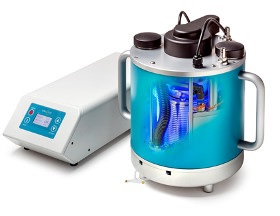Uniqsis expands LED photoreactor range

The availability of three new alternative switchable LED configurations provides chemists with the unique ability to optimally undertake almost any photochemistry reaction.
Uniqsis announces its PhotoSyn high-power photoreactor light module for continuous flow chemistry is now available with alternative LED array configurations that makes it compatible with a broader range of photochemical reactions.
The availability of three new alternative switchable LED configurations (blue, UVA-blue and blue-green-white) provides chemists with the unique ability to optimally undertake almost any photochemistry reaction. The operating wavelengths of the three LED array configurations are blue (455 nm), blue-green-white (455 nm, 530 nm and 420-700 nm) and UVA-blue (365 nm and 455 nm).
The curved, water-cooled LED arrays in the PhotoSyn are designed to maximise photon intensity and concentrate the available light on the independently temperature controlled central coil reactor. These high-quality LED’s have lifetimes of several years in continuous use without suffering a significant reduction in intensities.
The PhotoSyn incorporates a cooling fan to minimise undesirable radiative heating of the flow reactor whilst being cleverly engineered to completely prevent potentially hazardous light emissions from the unit, thereby avoiding the need to operate the instrument in a shielded enclosure. Moreover, the PhotoSyn is protected with safety interlocks that deactivate the light source and protect the user if any attempt is made to remove the cover whilst in use.
The PhotoSyn is compatible with both the Uniqsis Cold Coil standalone reactor module and the Polar Bear Plus Flow cryogenic flow reactor, which control the coil reactor temperature independently of the lamps. Reactions may be run from 150 °C down to sub-ambient temperatures dependent upon the power of the cooling unit used. The variable power supply allows the lamp power output to be adjusted from 10-100% making the unit suitable for both small scale R&D and scale up applications.
Related News
-
News Patients vs Pharma – who will the Inflation Reduction Act affect the most?
The Inflation Reduction Act brought in by the Biden administration in 2022 aims to give better and more equitable access to healthcare in the USA. However, pharma companies are now concerned about the other potential costs of such legislation. -
News CPHI Podcast Series: What does the changing US Pharma market mean for industry and patients alike?
In this week's episode of the CPHI Podcast Series Lucy Chard, Digital Editor for CPHI Online is joined by James Manser to discuss the political and market changes in the US pharma field. -
News CPHI Barcelona Annual Report illuminates industry trends for 2024
The CPHI Annual Survey comes into it’s 7th year to report on the predicted trends for 2024. Over 250 pharma executives were asked 35 questions, with their answers informing the industry landscape for the next year, spanning all major pharma marke... -
News Which 10 drugs are open to price negotiation with Medicare in the USA?
The Centres for Medicare & Medicaid Services, under the Biden administration in the USA, has released a list of the 10 drugs that will be open to price negotiations as part of the new legislation under the Inflation Reduction Act (IRA). -
News EU Medical Devices Regulation causes unintended disappearances of medical devices for children, doctors state
Doctor groups and associations have appealed to the EU to correct the EU Medical Devices Regulation law that may cause unintended shortages of essential drug and medical devices for children and rare disease patients. -
News 10 Major Drug Approvals So Far in 2023
Last year, 37 novel drugs were approved by the FDA, this was a high number for such a category, and covered many fields including oncology, demonstrating how promising further research is, and how it is only continuing to build. To date, there are alre... -
News Detecting Alzheimer's disease with a simple lateral flow test
A novel rapid diagnostic test for early-stage Alzheimer's disease has been developed using a biomarker binder from Aptamer Group along with technology from Neuro-Bio, the neurodegenerative disease experts. -
News CPHI Podcast Series: outsourcing and manufacturing trends
Listen to the CPHI Podcast Series this June to hear Gil Roth of the PBOA speak with Digital Editor Lucy Chard about the biggest trends and topics to watch in pharma outsourcing and manufacturing at the minute.
Position your company at the heart of the global Pharma industry with a CPHI Online membership
-
Your products and solutions visible to thousands of visitors within the largest Pharma marketplace
-
Generate high-quality, engaged leads for your business, all year round
-
Promote your business as the industry’s thought-leader by hosting your reports, brochures and videos within your profile
-
Your company’s profile boosted at all participating CPHI events
-
An easy-to-use platform with a detailed dashboard showing your leads and performance







